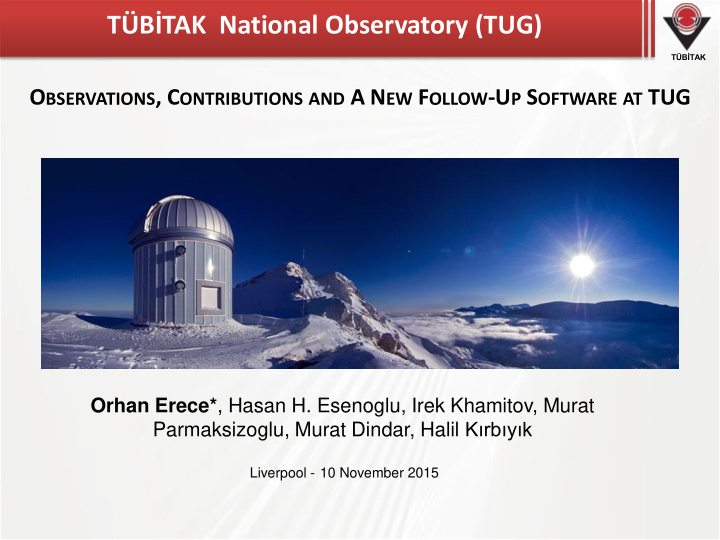



TÜBİTAK National Observatory (TUG) TÜBİTAK O BSERVATIONS , C ONTRIBUTIONS AND A N EW F OLLOW -U P S OFTWARE AT TUG Orhan Erece* , Hasan H. Esenoglu, Irek Khamitov, Murat Parmaksizoglu, Murat Dindar, Halil Kırbıyık Liverpool - 10 November 2015
Outline TÜBİTAK • Site Location • Telescopes and Instruments • Observations • A New long-term project • A New Follow-Up Software • Discussion • Conclusions
Site Location TÜBİTAK [A84] 30 ° 19'59.9''E, 36 °49'31.0'‘N Seeing: 1.57 ± 0.39 Elev.: 2500 m. 210 Clear Nights/Year
Telescopes and Instruments at TUG TÜBİTAK The three TUG telescopes have been dedicated to Gaia target of opportunity (ToO) observations in a limited observing time since the first test stages. The used observational quota status of Gaia alerts with TUG telescopes during 10 months in 2015 are the follows: 10% of RTT150, 16% of T100 and 0% of T60. The rest time will be used until the end of the year.
Telescopes and Instruments at TUG TÜBİTAK • RTT150, Russian - Turkish Telescope PROTOCOL: TÜBİTAK, Kazan Federal University, Russian Space Research Institute • 150 cm aperture, RC telescope • f/7.7 and f/48 CCD Cameras TFOSC CCD (2048x2048, 15 μ ) Time allocation to Andor DW436 (2048x2048, 13.5 μ ) follow-up Gaia Andor iXon EM CCD ToO (1024x1024, 13 μ ) 5 days/year Spectrographs TFOSC Coude DEFPOS
Telescopes and Instruments at TUG TÜBİTAK • T100 Fully Automatic & Remote Control Telescope • 100 cm aperture, f/10, RC telescope. • SI 4Kx4K, `Cryo-cooling` CCD • large FOV (21.5'x21.5‘) • 0.31’’/pixel • UBVRI, SDSS and narrow band filters • Installed in Sep. 2009 Time allocation to follow-up Gaia ToO 80 hours/year
Telescopes and Instruments at TUG TÜBİTAK • T60 Fully Robotic Telescope • 60 cm aperture, f/10, RC, robotic telescope. • FLI Proline 2Kx2K CCD, UBVRI, SDSS and narrow band filters • FOV: 17.5'x17.5' 0.51’’/pixel • Installed in Sep., 2010. • Mount Speed: RA: 11.1 deg/sec, Dec: 8 deg/sec. Time available for follow-up Gaia alerts of 15% of the total observation time
Telescopes and Instruments at TUG TÜBİTAK • ROTSE – IIID Fully Robotic Telescope • 45 cm aperture, f/1.80 • 2Kx2K CCD, no filter • large FOV (2.5 ⁰ x 2.5 ⁰ ) • Four telescopes in ROTSE network. (Australia, Africa, Turkey, USA) • Dedicated to observations transients in optical window. PROTOCOL: TÜBİTAK, Michigan University The pilot observations will begin in 2016.
Observations so far TÜBİTAK RTT150 T100 T60 65 frames 106 frames 10 frames Gaia15aff 2014J Gaia15adb Gaia15acz Gaia15afd ASASSN-13dd Gaia15acx Gaia15aey 2014J Gaia15adb Gaia15acp iptf13ebh ASASSN-13ddd Gaia15aaf Master_OT_J1204 51.50+265946.6 CSS100215:12245 4+212246 ON325-10 ASASSN-14bb 2014J ASASSN-14ae http://gsaweb.ast.cam.ac.uk/followup/observatories
Observations so far TÜBİTAK It has been taken the total photometric observations of 181 frames (the ratio of about 1% of all Gaia images) at TUG since the first observation was Asassn13dd in Oct. 2013. It was observed the total number of 17 objects.
Projects in TUG TÜBİTAK An aim of a project newly proposed to T100 telescope is time-resolved observations of Cataclismic Variables (CVs) detected from Gaia alerts ToO observations. This project is a scheduled project totally independent of reserved time of Gaia ToO observations.
Projects in TUG TÜBİTAK Time-resolved observations of cataclysmic variables of Gaia objects Determining the orbital and superhump periods of selected Gaia objects There are initially 4 candidate cataclysmic variables of Gaia alerts 15aeo, 15adf, 14aat and 14adk according to the object visibility Project was proposed by Hasan H. Esenoglu for T100 telescope and the link for cooperation hasan.esenoglu@tubitak.gov.tr
T60 Robotic Telescope TÜBİTAK One of the most important developments in TUG is a new follow-up software. The software has been used officially at T60 telescope since June, 2014. It listens NASA's Atlas server where GRB alerts are collected. Alerts are automatically taken from this server and prepared for observation appropriately by the new software in a relatively short time. This software can be easily adapted to a server running for Gaia alerts if there is a similar server and format for listening of them.
A New GRB Follow-Up Software TÜBİTAK • Software Architecture: TCS-TALON, formerly OCAAS. The missing part in TALON: No modul (daemon) for Follow-Up. Dindar et al, “ A new software on TUG-T60 autonomous telescope for astronomical transient events ”, Experimental Astronomy, 2015.
A New GRB Follow-Up Software TÜBİTAK • Samples: First GRB 141225A* GRB Publication T-GRB Magnitude Comments *141225A GCN17240 129 s 17.04 Succeeded V404 Cygni - 88s - Succeeded 150626B - 90 s > 17.5 Out of limits of magnitude 150619A - 125 s - Bad weather conditions: Cloudiness *E. Sonbas et al, “GRB 141225A: very early T60 observations“, http://gcn.gsfc.nasa.gov/gcn3/17240.gcn3
Future Works TÜBİTAK • The software is ready for Gaia alerts if it is required. • Publishing the alerts to other telescopes at TUG Site. • The software can be run optional at RTT150 and T100 telescopes.
Conclusions TÜBİTAK • A new long-term project accepted • Test observations are starting in 2016 for ROTSEIIId • A New Follow-Up System for TUG telescopes • The software can run for Gaia alerts of all TUG telescopes
TUG TÜBİTAK
Recommend
More recommend